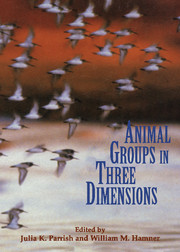Book contents
- Frontmatter
- Contents
- List of contributors
- Acknowledgments
- 1 Introduction – From individuals to aggregations: Unifying properties, global framework, and the holy grails of congregation
- Part one Imaging and measurement
- 2 Methods for three-dimensional sensing of animals
- 3 Analytical and digital photogrammetry
- 4 Acoustic visualization of three-dimensional animal aggregations in the ocean
- 5 Three-dimensional structure and dynamics of bird flocks
- 6 Three-dimensional measurements of swarming mosquitoes: A probabilistic model, measuring system, and example results
- Part two Analysis
- Part three Behavioral ecology and evolution
- Part four Models
- References
- Subject index
- Taxonomic index
3 - Analytical and digital photogrammetry
from Part one - Imaging and measurement
Published online by Cambridge University Press: 01 June 2010
- Frontmatter
- Contents
- List of contributors
- Acknowledgments
- 1 Introduction – From individuals to aggregations: Unifying properties, global framework, and the holy grails of congregation
- Part one Imaging and measurement
- 2 Methods for three-dimensional sensing of animals
- 3 Analytical and digital photogrammetry
- 4 Acoustic visualization of three-dimensional animal aggregations in the ocean
- 5 Three-dimensional structure and dynamics of bird flocks
- 6 Three-dimensional measurements of swarming mosquitoes: A probabilistic model, measuring system, and example results
- Part two Analysis
- Part three Behavioral ecology and evolution
- Part four Models
- References
- Subject index
- Taxonomic index
Summary
Introduction
Photogrammetry is the “art, science, and technology of obtaining reliable quantitative information about physical objects and the environment through the process of recording, measuring and interpreting photographic images and patterns of radiant imagery derived from sensor systems” (Karara 1989). This chapter is an introduction to photogrammetry and its application to biological measurement as it relates to the analysis of an animal's position and motion within a three-dimensional aggregation of similar individuals. The principle analytical methods of measuring three-dimensional coordinates from two photographic images, the geometric basis of stereovision, and three-dimensional visualization are described. Although I concentrate on two-camera systems, the principals can be extended to multistation photogrammetry. I use typical commercial photogrammetric systems and recent applications to illustrate the use of photogrammetry and its costs and complexity.
Measurement techniques are centrally important to all of the discussions of three-dimensional animal aggregations in this book. Humans capture images of their surroundings through paired two-dimensional, camera-like eyes, and our brains are able to instantly reconstruct complex images that accurately reflect the three-dimensional world. We make measurements of distance, volume, shape, color, and motion with blinding speed, and we react behaviorally to this incredibly complex array of information with reliability and safety. We take these astonishing feats of visual performance for granted, and it is only when we attempt to recreate simple three-dimensional optical tasks with cameras and computers that we begin to appreciate the actual complexity of three-dimensional optical measurement.
- Type
- Chapter
- Information
- Animal Groups in Three DimensionsHow Species Aggregate, pp. 36 - 60Publisher: Cambridge University PressPrint publication year: 1997
- 2
- Cited by



